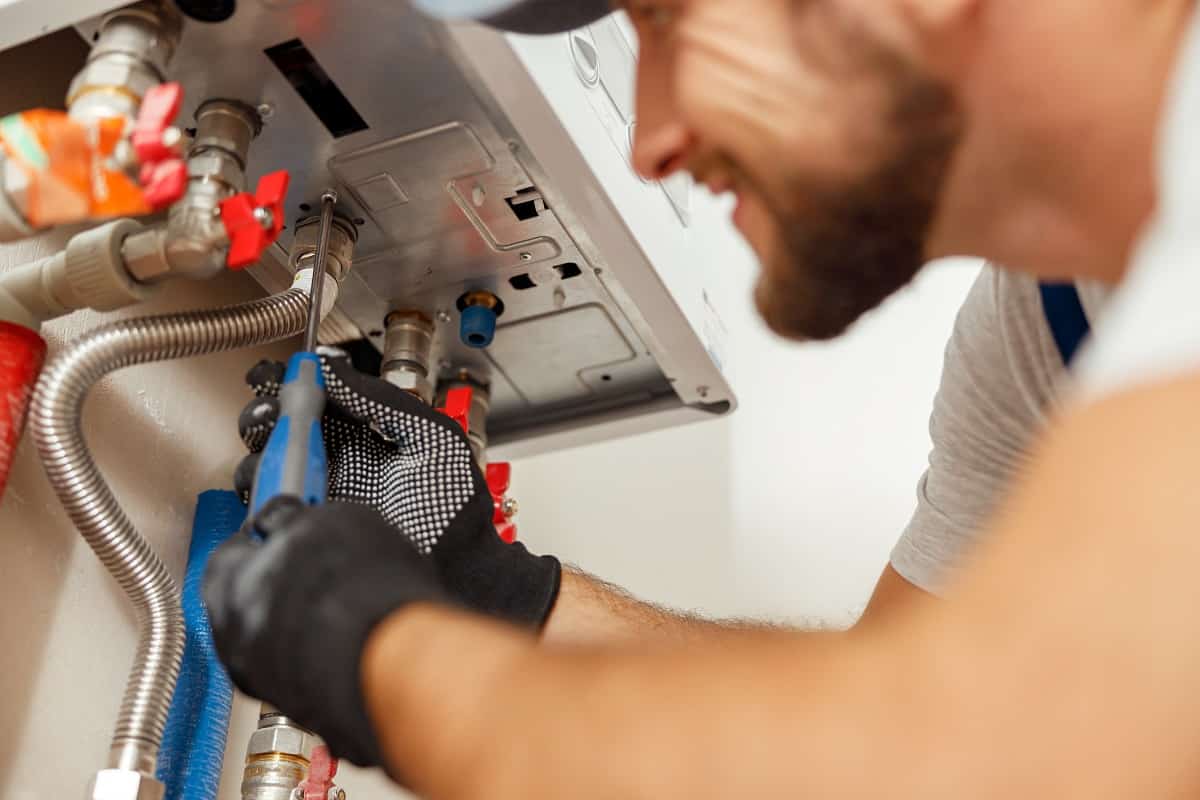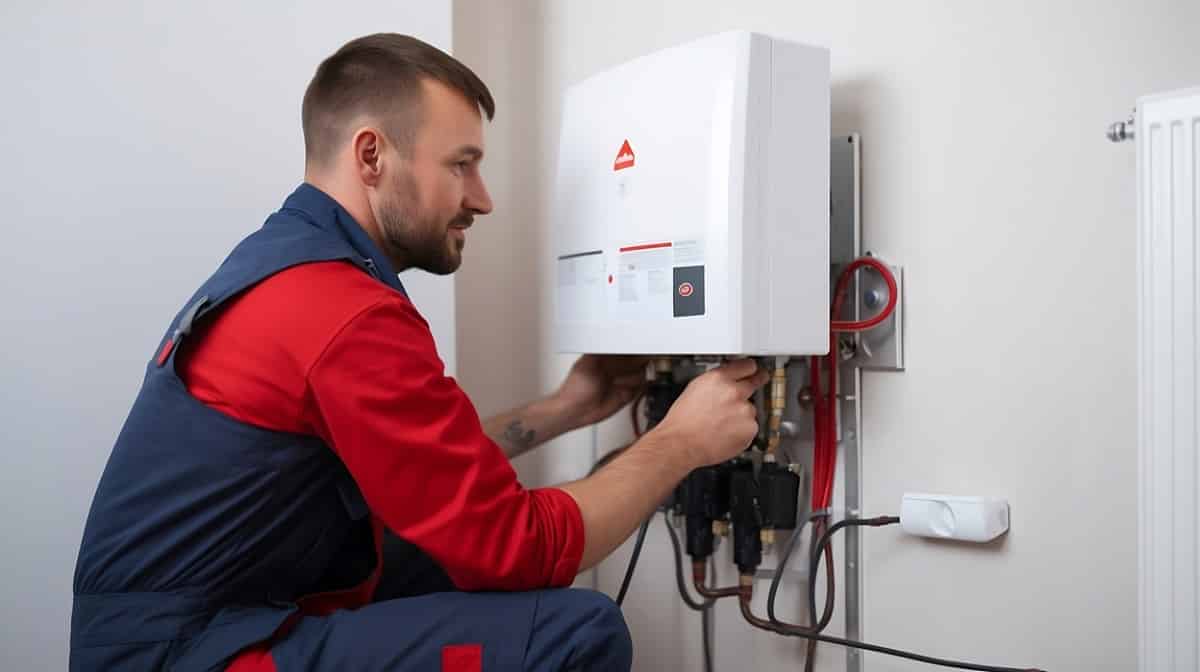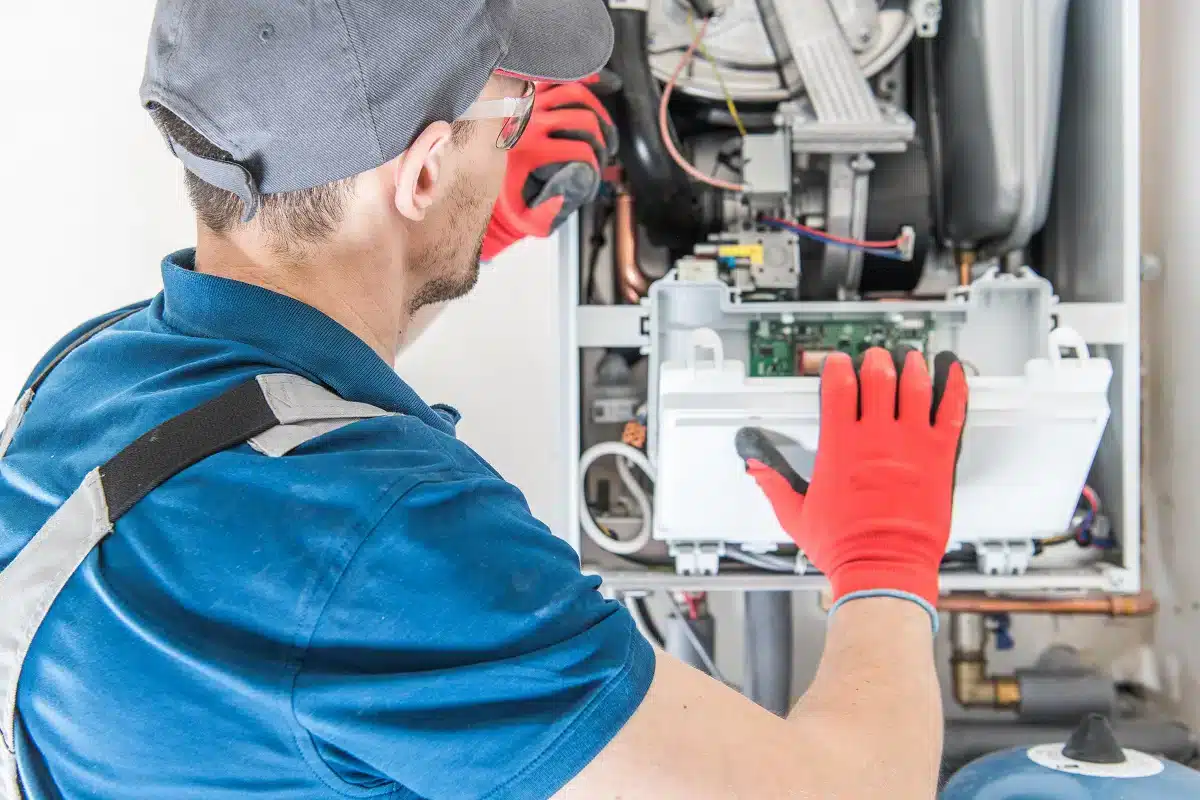 Essential Tips: How To Increase Boiler Pressure Effectively
Essential Tips: How To Increase Boiler Pressure Effectively

Ever glanced at your boiler’s pressure gauge and seen the needle hovering below 1? It’s a common sight, but one that could spell trouble for your heating system. That’s where knowing how to increase boiler pressure comes in handy.
If you think maintaining optimal boiler pressure is just for seasoned engineers, think again! You see, with some basic knowledge and practical steps (and safety measures), you can get that dial pointing towards the ideal range – usually between 1 and 2 bars. And guess what? We’re here to guide you through it all!
This post isn’t about fancy jargon or complex theories; instead, we’ve stripped down everything into digestible tips. From understanding high boiler pressures to learning how to use internal or external filling loops – we’ve got it covered. But don’t think the journey ends here… Be vigilant for what lies ahead.
Understanding Boiler Pressure
Boiler pressure, a crucial player in the central heating system game. Think of it as the blood pressure for your home’s warmth and hot water supply.
What is High Boiler Pressure?
“High boiler pressure”, sounds menacing, doesn’t it? It can be. When your boiler’s pressure gauge points to anything above 2 bar, you’re stepping into high-pressure territory. This unwanted guest might lead to potential problems with your heating system. Overworking parts could wear out sooner or cause damage over time.
How to Check Your Boiler Pressure
Fancy playing detective? Checking boiler pressure isn’t rocket science and we’ve got a guide just for that. All boilers come equipped with a built-in water pressure gauge – often located on its front panel display. The magic numbers are between 1 and 2 bar – this range indicates safe operation without causing an unnecessary strain on the components within. Any lower or higher may signal trouble ahead.
A quick step-by-step: Safely access your boiler (no teetering off ladders please). Pull up a chair if needed, don’t rush this part. Gently wipe any dust from the display panel using a soft cloth – no sprays though. You wouldn’t want water damage now would you?
Note: If you have questions about checking your own boiler manual will give tailored advice specific to your model.
Need help immediately? Our friendly team today at Plumbers 4U, always ready with practical solutions.
So there we have it folks; understanding how vital maintaining correct pressures in your boiler is for an efficient and trouble-free heating system. But remember, when it comes to gas appliances – if you’re unsure about anything at all, always seek help from a Gas Safe registered engineer.
Key Takeaway:
Boiler pressure, similar to your home’s ‘blood pressure’, is crucial for effective heating. If the boiler pressures go above 2 bar, it can put a strain on the system and potentially cause damage. You can simply check this using the built-in water gauge on your boiler; ideal numbers are between 1 and 2 bar. But remember, if you’re ever unsure about any issue with a gas appliance, don’t hesitate to seek professional help.
Common Causes of Low Boiler Pressure
Boilers, like humans, can feel a bit under the weather. And when your boiler’s pressure drops too low, it’ll struggle to heat your home. Let’s delve into two key reasons why boilers lose pressure over time: filling loop issues and bleeding radiators.
Filling Loop Issues
The filling loop, that small silver hose connected to your boiler system, is essential for maintaining correct water pressure levels. It’s a gateway allowing mains cold water to enter your central heating circuit. If not closed properly after use or if it develops a leak, you’ve got yourself an unwanted pressure loss situation. Make sure those valves are tightly shut.
Impact of Bleeding Radiators
Bleeding radiators – sounds spooky but really isn’t. It simply means letting out trapped air from radiators using a radiator key or flat-head screwdriver. This procedure can cause a sudden drop in boiler pressure though. Why? Because you’re essentially removing volume (air) from the sealed central heating system without replacing it (with water).
Note:A quick glance at the built-in boiler pressure gauge would give away any dramatic dips in water pressures.
In case you’re losing sleep over these technicalities, our friendly team is just one call away (01295 224844). Remember folks, low water pressure is a common reason for boiler malfunction.
Next time your heating system throws a fit with dropping pressures, you’ll know what to check first.
Filling loop issues? Bleeding radiators? Now they won’t catch you off guard. And always remember: When in doubt, it’s best to get professional help from an accredited installer.
Feeling the chill with low boiler pressure? Don’t lose sleep, it could be a filling loop issue or radiators needing a bleed. Keep an eye on that gauge and when in doubt, call in the pros. #BoilerPressureTips
Click to Tweet
How to Increase Boiler Pressure Using an Internal Filling Loop
If your boiler’s feeling under the weather, don’t fret. Low pressure might be the culprit and we’ve got a fix. You’ll need to locate that internal filling loop first.
Locating Your Internal Filling Loop
Your keyless internal filling loop should be underneath your boiler unit. Look for two tap handles with a flexible silver tube connecting them – this is it. If you can’t find it, give our friendly team today (01295 224844). We’re always here to help out.
Adjusting the Tap Handles
The next step? Get those tap handles moving. Let’s crank up that water pressure gauge reading by adjusting these bad boys correctly.
- To start, turn off your heating system. This will let us work safely on increasing its performance.
- Carefully open both handle valves completely using either an isolation valve or handle valve tool until they’re in line with their corresponding pipes. This allows cold mains water into your central heating circuit from one side while letting air escape through another pipe on the other side of the boiler – think of it as creating a refreshing drink for thirsty radiators.
- Keep an eye on that handy-dandy pressure gauge during this process – when it hits between 1 and 1.5 bar, close both taps immediately so no more water enters into circulation within the boiler itself. Otherwise, too much could cause high-pressure issues later down the line, which isn’t fun, trust me, I’ve been there before.
Not seeing any change? Or worse still- have things gone south even further?
If the pressure levels are still elusive, you may be facing a more intricate problem. And that’s where we come in. We’re just one call away from sorting out your boiler woes – contact our friendly team today (01295 224844).
Key Takeaway:
Feeling cold? Your boiler’s low pressure could be the culprit. Here’s a swift solution: find the internal filling loop under your boiler, which links two tap handles with a flexible silver tube. Make sure to switch off your heating first, then open both handle valves completely – this lets water into your system and allows air to escape at the same time. Keep an eye on that pressure gauge; once it reaches its optimum level, you’re good to go.
How to Increase Boiler Pressure Using an External Filling Loop
Ever noticed your boiler acting up? It might be low pressure. Don’t fret, we’ve got the solution.
Identifying Your External Filling Loop
The external filling loop isn’t as scary as it sounds. It’s just a silver connection or braided hose that bridges the gap between your heating system and mains cold water supply. You’ll find this lifesaver near the bottom of your boiler unit, patiently waiting for its time in the spotlight. Got it?
Adjusting the Loop Valves
Fabulous. Now onto adjusting those all-important loop valves.
- A twist is all you need: Tighten them until water starts flowing into your central heating circuit – no need for Herculean strength here.
- Catch my drift?: If not, check out our detailed guide on increasing boiler pressure with an external filling loop. The right knowledge makes every task easier.
- Mindful monitoring: This bit’s crucial – keep one eye on that gauge while letting water flow in. You want to aim for around 1-1.5 bar (the green zone).
- Pull up stakes: Last but not least, turn off both valves tightly when done – leaving any open can cause high boiler pressure later down the line. That’s a problem for another day.
And voila. You’ve successfully used an external filling loop to increase boiler pressure.
Why not contact our helpful staff today to see how they can assist with your heating requirements? We’re always ready to help out with your heating needs.
Ever had a grumpy boiler? A twist of the loop valves might just be the pick-me-up it needs. Boost your boiler pressure with an external filling loop and banish those heating woes. Remember, keep an eye on that gauge – 1-1.5 bar
Step-by-Step Guide to Increasing Boiler Pressure
If your boiler’s acting up, don’t fret. We’ve got a handy guide for you.
Spotting the Reset Button
You’ll need this if pressure gets too high. Find it on the display panel.
Finding Your Filling Valves
No key? No problem. You’re likely dealing with a Gas Safe registered boiler with keyless internal filling valves.
Ramping Up The Pressure Levels
The water stops flowing when correct pressure is achieved. Look out for that.
A Little More About That…
The mains cold water flows into the central heating circuit through those valves we talked about earlier. As they open, pressure levels rise in the boiler and hot water starts its journey around your home’s radiators – warm toes all round.
Tightening Those Valves Tightly Now…
Careful though – too much of anything isn’t good. If you see pressure gauges rocketing towards red zones (that’s 2 bar or more), time to ease off and close them valves tightly again until things calm down.
Note: Always remember, overdoing it can cause more harm than good.
Checking Boiler Pressure After Your Handy Work
Your boiler’s pressure gauge should now read between 1 and 2 bar. If it does, congrats. You’ve just successfully increased your boiler pressure.
Note: Too much fiddling can lead to a high-pressure warning or worse, water damage.
Got a boiler playing up? Don’t worry, we’ve got you covered. From spotting the reset button to adjusting pressure levels and even dealing with keyless valves – heating your home just got easier. Remember: safety first. #HomeMaintenance #BoilerTips
Troubleshooting High Boiler Pressure
High boiler pressure isn’t just a minor hiccup. It can lead to water damage and other serious problems.
Recognizing Signs of High Boiler Pressure
The first step is knowing what high boiler pressure looks like. Your trusty pressure gauge will tell you if things are getting steamy. Anything above 2 bar is too much, even for your sturdy central heating circuit. If the needle’s in the red, it’s time to act fast.
Addressing High Boiler Pressure Issues
Luckily, fixing high boiler pressure isn’t rocket science. To start with, check that your radiators aren’t hot at the top but cold at the bottom – this could mean they need bleeding which may help reduce the pressure levels.
- Bleed your radiators: Bleeding helps get rid of any air trapped inside them that might cause an increase in pressure. You’ll also want to inspect all visible pipes and joints for leaks – remember water stops being fun when it causes property damage.
- Last resort? The reset button. Sometimes a simple system restart can work wonders.
But always remember: safety comes first. If you’re not comfortable dealing with pressurised systems or feel unsure about any steps involved; do yourself a favour and call up our friendly team today (01295 224844). They’ll be able to provide further guidance or recommend an accredited installer who’s Gas Safe registered.(Remember kids don’t try DIY gas work at home).
By staying vigilant and addressing high pressure issues quickly, you can ensure your boiler stays in tip-top shape.
Tips for Maintaining Optimal Boiler Pressure
Boiler pressure, the magic key to a warm home and hot water. But, it’s not all about high boiler numbers. The secret lies in balance.
Regular Pressure Checks
First off, make friends with your boiler pressure gauge. A happy boiler hums at 1-2 bar of pressure. So check regularly and note any changes. If you see the needle drop below one or climb above two bars on your central heating system’s water pressure gauge – it’s time to take action.
Maintain Your Heating System Regularly
Routine is king when it comes to keeping your high boilers singing sweetly. A bit like brushing teeth or feeding pets, but less often (phew.).
Schedule regular service checks by accredited installers every year. It can help nip potential issues before they turn into full-blown dramas. Remember: Prevention is better than cure…and cheaper too.
Detecting Pressure Changes Early
Noisy pipes? Radiators cold at bottom? Water stops flowing?
All these are signs that something might be amiss with the pressure levels in your central heating circuit. If so, don’t hesitate. Contact our friendly team today on 01295 224844, we’re here to give you a hand with your boiler work.
Protecting Against Pressure Loss
Avoid unnecessary pressure loss. If the cold water mains in your area have low pressure, use a pump to help increase boiler pressure.
Also remember: after bleeding radiators, always check and adjust the boiler’s water pressure if needed.
Treating Your Boiler Right
Boilers are like people – treat them well and they’ll serve you faithfully for years.
If you spot any signs of wear or damage on the valves or filling loop, don’t delay. Get them replaced by a Gas Safe registered engineer right away to prevent future problems.
Key Takeaway:
Boiler pressure is key to a cosy home. Keep an eye on your gauge, aiming for 1-2 bar. Regular service checks by certified pros can prevent costly issues later. If you spot warning signs like noisy pipes or cold radiators, don’t hesitate – get help. And remember, if your area has low water mains pressure, use a pump to increase it and ensure that warm comfort isn’t compromised.
Conclusion
Cracking the code on how to increase boiler pressure isn’t rocket science. With a little knowledge and caution, you can get your heating system back in full swing.
Remember, high boiler pressure is just as problematic as low. Stay alert for any signs of trouble and take swift action.The internal or external filling loop – they’re not alien devices! Use them effectively to manage water levels in your central heating circuit. If ever things feel overwhelming though, don’t hesitate to call up our friendly team today! In essence, maintaining optimal boiler pressure is all about vigilance and timely action. Stick with it – you’ve got this!


